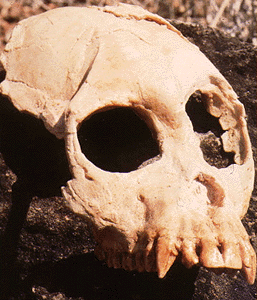
Evolutionary Theory Applied to Human Origins. Once Darwin had defined a process by which separate species could emerge from an ancestral lineage, it remained to apply his theory to the issue of human origins. In his second ground-breaking work, The Descent of Man (1871), Darwin concluded, on the evidence available to him, that our species shared a remote common ancestor with the great apes. Darwin suggested further that the most likely site of human origins was Africa, home of the gorilla and chimpanzee, species that he regarded, on anatomical evidence, as our closest living relatives.

Subsequent fossil discoveries have borne out Darwin's early observations. Above is a remarkably well-preserved skull of Proconsul africanus (sometimes called Dryopithicus africanus or "woodland ape"), discovered in 1948 in east Africa. This gibbon-sized animal roamed the forests of the Miocene period roughly 18 million years ago. This creature appeared after monkeys and apes had diverged into separate families of species. Structurally, Proconsul appears to be the best candidate yet discovered to be the origin point of our large "family" of species. That is, Proconsul is probably the distant ancestor from which modern species of apes and hominids — human beings included — have evolved.